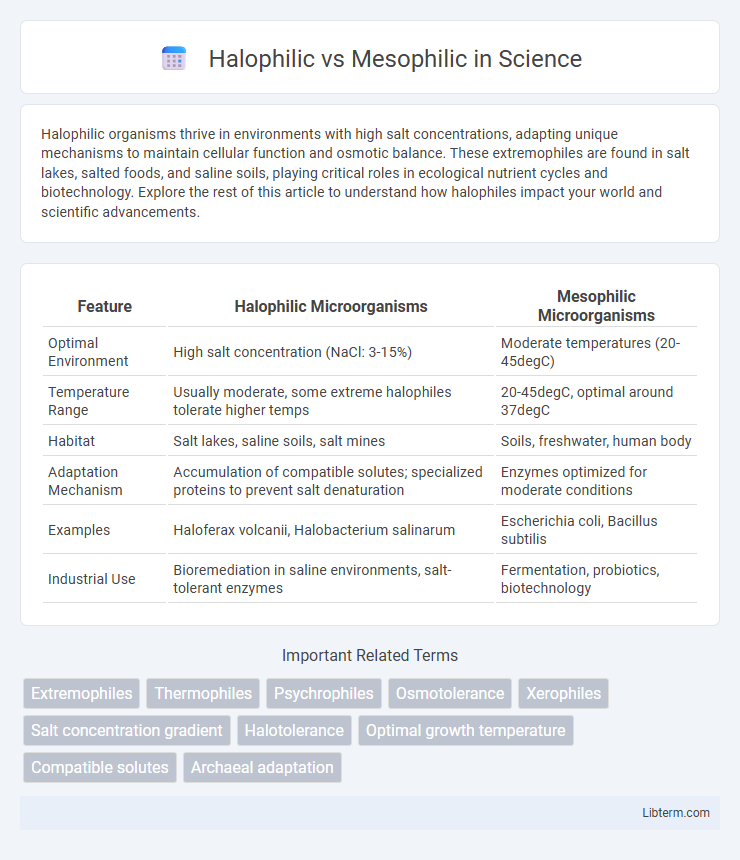Halophilic organisms thrive in environments with high salt concentrations, adapting unique mechanisms to maintain cellular function and osmotic balance. These extremophiles are found in salt lakes, salted foods, and saline soils, playing critical roles in ecological nutrient cycles and biotechnology. Explore the rest of this article to understand how halophiles impact your world and scientific advancements.
Table of Comparison
| Feature | Halophilic Microorganisms | Mesophilic Microorganisms |
|---|---|---|
| Optimal Environment | High salt concentration (NaCl: 3-15%) | Moderate temperatures (20-45degC) |
| Temperature Range | Usually moderate, some extreme halophiles tolerate higher temps | 20-45degC, optimal around 37degC |
| Habitat | Salt lakes, saline soils, salt mines | Soils, freshwater, human body |
| Adaptation Mechanism | Accumulation of compatible solutes; specialized proteins to prevent salt denaturation | Enzymes optimized for moderate conditions |
| Examples | Haloferax volcanii, Halobacterium salinarum | Escherichia coli, Bacillus subtilis |
| Industrial Use | Bioremediation in saline environments, salt-tolerant enzymes | Fermentation, probiotics, biotechnology |
Introduction to Halophilic and Mesophilic Organisms
Halophilic organisms thrive in high-salt environments, often found in salt lakes, saline soils, and seawater, adapting their cellular machinery to maintain osmotic balance and enzyme function under extreme salinity. Mesophilic organisms, in contrast, prefer moderate temperature ranges between 20degC and 45degC, commonly inhabiting soils, water, and the human body, optimizing metabolic processes for these stable conditions. Both types exhibit specialized adaptations that reflect their environmental niches, influencing biotechnology applications such as bioremediation and industrial fermentation.
Defining Halophiles: Extreme Salinity Adaptation
Halophiles are microorganisms that thrive in environments with extremely high salt concentrations, often exceeding 20% NaCl, showcasing specialized adaptations to osmotic stress and ion toxicity. Unlike mesophilic organisms, which grow optimally at moderate temperatures and salt levels, halophiles possess unique cellular mechanisms, including compatible solute accumulation and specialized ion pumps, to maintain cellular function and stability in hypersaline habitats. These adaptations enable halophiles to colonize extreme environments such as salt lakes, saline soils, and salt evaporation ponds where conventional mesophiles cannot survive.
Mesophiles: Thrive in Moderate Environments
Mesophiles thrive in moderate environments with optimal temperatures ranging from 20degC to 45degC, making them abundant in soil, water, and the human body. These microorganisms play crucial roles in ecosystems by decomposing organic matter and contribute significantly to human health and industrial processes such as fermentation. Unlike halophiles, which require high salt concentrations, mesophiles prefer environments with moderate salinity and moisture levels.
Environmental Niches: Where Halophiles and Mesophiles Exist
Halophiles thrive in high-salinity environments such as salt flats, salt mines, and hypersaline lakes, where salt concentrations often exceed 15%. Mesophiles inhabit moderate environments including soil, freshwater, and the human body, typically thriving between 20degC and 45degC without extreme salinity. These distinct environmental niches highlight the adaptations in cellular processes and osmoregulation specific to halophilic and mesophilic microorganisms.
Cellular Mechanisms of Salt Tolerance in Halophiles
Halophilic organisms employ specialized cellular mechanisms to maintain osmotic balance in high-salt environments, such as accumulating compatible solutes like glycine betaine and synthesizing salt-stable enzymes to prevent protein denaturation. Their cellular membranes contain unique lipid compositions that enhance stability and functionality under hypersaline conditions, while ion pumps actively regulate intracellular sodium and potassium levels to avoid toxic ion accumulation. In contrast, mesophilic organisms lack these adaptations, making them susceptible to osmotic stress and inhibited growth in saline environments.
Temperature Preferences: A Key Difference
Halophilic microorganisms thrive in high-salt environments, with temperature preferences ranging from moderate to extreme (25degC to 80degC), while mesophilic organisms prefer moderate temperatures between 20degC and 45degC. Halophiles often adapt to hypersaline habitats such as salt lakes and saline soils, where temperature fluctuations can be significant. Mesophiles commonly inhabit environments like soil, water, and the human body, maintaining optimal growth within narrow temperature ranges ideal for cellular function.
Industrial and Biotechnological Uses of Halophiles
Halophilic microorganisms thrive in high-salt environments and produce stable enzymes that function efficiently under extreme saline conditions, making them valuable for industrial processes such as bioremediation, biofuel production, and the synthesis of compatible solutes like ectoine used in cosmetics. Unlike mesophilic organisms that prefer moderate conditions, halophiles offer enhanced stability and activity in harsh industrial environments where high salinity often inhibits conventional microbial catalysts. Their unique metabolic pathways enable sustainable biotechnological applications, including salt-tolerant bio-catalysts for pharmaceuticals, food fermentation, and waste treatment in saline wastewaters.
Applications of Mesophilic Organisms in Biotechnology
Mesophilic organisms, thriving at moderate temperatures between 20degC and 45degC, are extensively utilized in biotechnology for processes such as fermentation, enzyme production, and waste treatment. These microbes facilitate the industrial synthesis of antibiotics, biofuels, and food products like yogurt and cheese due to their stable metabolic activities. Their adaptability to controlled environments makes them ideal for large-scale bioprocesses, enabling efficient bioconversion and bioremediation applications.
Comparative Genomics: Halophilic vs Mesophilic Adaptations
Comparative genomics reveals that halophilic organisms possess specialized genes encoding for ion transporters and osmoprotectant synthesis, enabling survival in hypersaline environments, whereas mesophilic organisms exhibit genomic features optimized for moderate, stable conditions. Halophiles show an abundance of genes related to DNA repair, protein stability, and salt-tolerant enzymes, contrasting with mesophiles' reliance on homeostatic mechanisms suited for moderate ionic strength. Genomic adaptations in halophiles include expanded gene families for compatible solute biosynthesis and salt efflux, highlighting evolutionary strategies distinct from those of mesophilic species.
Future Research Directions in Extremophile Studies
Future research in extremophile studies will focus on genomic and proteomic analysis of Halophilic and Mesophilic organisms to uncover adaptive mechanisms to diverse environments. Advancements in CRISPR and synthetic biology may enable engineering of extremophiles for biotechnological applications including bioremediation and bioenergy. Integrating metagenomics with environmental data will enhance understanding of microbial ecology and potential industrial exploitation of these microbes.
Halophilic Infographic

 libterm.com
libterm.com